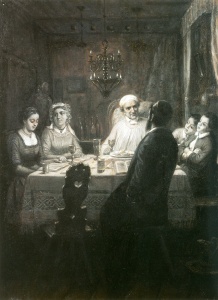A Unique Seder: A Painting in Grisaille by Moritz Daniel Oppenheim at the Jewish Museum
This image of the Passover Seder by Moritz Daniel Oppenheim (1800-1882) was found in almost every German Jewish 19th century home as part of the immensely popular graphic albums called “Pictures of Traditional Jewish Family Life.” In a previous Jewish Arts column I discussed the background and historical significance of Oppenheim’s work. Now I would like to look at one of these paintings in detail. The tools of our encounter with a work of art are an analysis of what we are seeing, how has the artist made this image and what meaning is communicated.

The name given by the artist to this painting, Paschal Eve, was obviously meant mollify the large Christian audience the albums were marketed to. The subject is the beginning of the Passover Seder since on the table only there are only the Haggadahs, the wine cups, Elijah’s cup and the Passover plate and not the yom tov meal. The father, centrally placed and well lit, is dressed in a kittel, appropriate for the evening. We see behind him and to the left four bottles of wine, one partially reduced in quantity. The first cup has been poured, kiddush has been recited, and the telling has begun. The mother reassures her grown daughter by holding her hand as the daughter lowers her eyes modestly and gazes into the Haggadah before her. Two younger boys are listening on the right and observing the unfolding drama, not necessarily of the Exodus, but rather of a prospective match for their older sister. A dark mystery guest in the foreground, sitting with his back to us, fuels the entire scene. He is in Hasidic garb and seems engaged in conversation with the father directly across the table. It was common for 18th century German Jews to hire Eastern European Hasidim as religious tutors for their children. On our side of the table, opposite the mother and her daughter there is an empty chair with a heart shaped design in the middle of the carved back. At the very least there are two stories unfolding this evening.
Oppenheim has set this Seder in the rather shallow space of a small room illuminated by a traditional hanging oil Shabbos lamp. The family figures are uniformly lit in a horizontal frieze with the exception of the white on white kittel of the father and the dark silhouetted foreground figure. The composition is focused on the middle third of the painting with a band of light across the center. While on the right the curtains take us to the right top of the painting, the rest of the top and the entire bottom of the painting have almost no visual interest. What the artist has done is to take the occasion of the Seder as an excuse to tell us another story. He is in fact quite skillful and subtle in his subterfuge of the Passover Seder. The father, his sons and the guest form a male trilogy on the right side of the painting. Whatever their differences in age, attire or religiosity, they form a cohesive visual group. On the left are the mother and her blushing daughter with the empty ‘love’ chair in front of them, waiting to be filled by the guest as a hoped for future husband and son-in-law. The artist has supplanted the “and you shall tell your son” of the Haggadah with the more prosaic, “and you shall marry off your daughter”.
Moritz Oppenheim stands in a long line of painters of genre (everyday life) scenes starting with 17th century Dutch interior painters like Vermeer and Jan Steen, continuing to the Englishman William Hogarth and to the Americans Winslow Homer and Norman Rockwell. There are important distinctions among these artists. Some made illustrations and some made complete works of art. A superficial description (or rendering) of an idea or a scene is illustration. A work of art will attempt to use all aspects of the painting, the color, light, drawing and form, to combine a number of complex ideas to arrive at a new understanding of its subject. The object of a work of art is to challenge the viewer to think more deeply about its subject and to somehow make a new connection with meaning.
Oppenheim is an entertaining 19th century artist within the German genre painting tradition whose main talent was in sentimental illustrations of Jewish life. He was the first Jewish artist in history to depict these subjects. His messages are simple and easy to understand and, once “read,” charming. But, indeed, once “read,” what is the specifically Jewish content of this painting? That is the job of the viewer, using the tools enumerated above, to determine.
JEWISH MUSEUM
1109 Fifth Avenue
New York, N.Y.